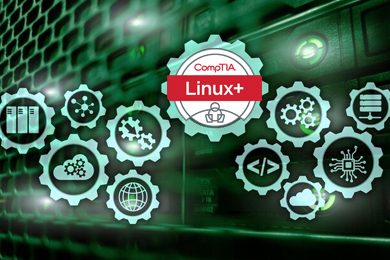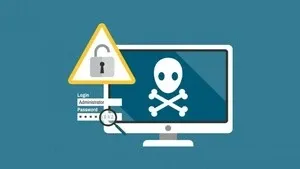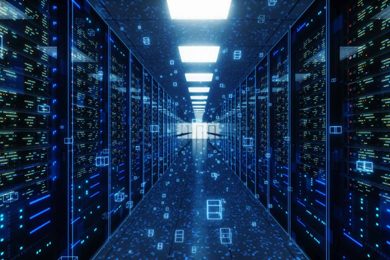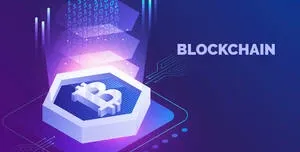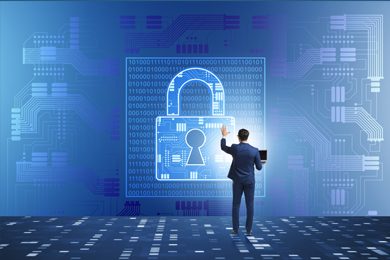This plan includes
- Limited free courses access
- Play & Pause Course Videos
- Video Recorded Lectures
- Learn on Mobile/PC/Tablet
- Quizzes and Real Projects
- Lifetime Course Certificate
- Email & Chat Support
What you'll learn?
- Linux System Administration: Gain a comprehensive understanding of Linux system administration tasks, including user and group management, file permissions etc
- Networking in Linux: Learn how to configure network interfaces, manage network connections, troubleshoot networking issues, and implement basic network services
- Acquire the skills to implement Linux security measures, manage user and group permissions, secure network services, configure firewalls, and cryptography
- Develop the ability to diagnose and troubleshoot common Linux system issues, perform system backups and restores, manage system logs
Course Overview
Pre-requisites
- The CompTIA Linux+ certification does not have formal prerequisites. However, it is beneficial to have basic computer skills, familiarity with operating systems, and a basic understanding of networking fundamentals. Practical experience with Linux systems is also recommended to reinforce the knowledge gained in the course and enhance exam success.
Target Audience
- This course is designed for individuals who are interested in becoming Linux administrators or advancing their Linux administration skills. It is suitable for beginners who are new to Linux as well as experienced IT professionals looking to expand their knowledge and obtain the CompTIA Linux+ certification.
Curriculum 135 Lectures 19:02:17
Section 1 : Introduction
Section 2 : Setup LAB for Linux Administration
- Lecture 1 :
- Install Kali Linux on Virtualbox
- Lecture 2 :
- Install RHEL 9 on virtualBox
Section 3 : Introducing Linux
- Lecture 1 :
- Characteristics of Free Open Source Software
- Lecture 2 :
- Linux History and features
- Lecture 3 :
- Understanding Linux Distributions (Gui vs CLI)
- Lecture 4 :
- Bash Shell and command Structure with Example
- Lecture 5 :
- Bash Tab Completion and History LAB
- Lecture 6 :
- Text Editor Vim and Nano in Linux
- Lecture 7 :
- Introducing Su and Sudo
- Lecture 8 :
- Identify Common Directories in Linux
- Lecture 9 :
- Linux Basic uses LAB
- Lecture 10 :
- Use Help in Linux
- Lecture 11 :
- Identify the Linux Troubleshooting Methodology
Section 4 : Administering Users and Groups
- Lecture 1 :
- Manage user Accounts part 1
- Lecture 2 :
- User Configuration files and management commands
- Lecture 3 :
- Manage the Group - Create Group
- Lecture 4 :
- Manage Groups - Modify the Group
- Lecture 5 :
- Configure Privilege Escalation
- Lecture 6 :
- Policykit Configuration
- Lecture 7 :
- Troubleshoot User and Group Issues
Section 5 : Configuring Permissions
- Lecture 1 :
- Standard Linux permission access level and identities
- Lecture 2 :
- LAB on Standard Linux permission access level and identities
- Lecture 3 :
- Interpret and set the Permissions with LAB
- Lecture 4 :
- Symbolic mode permission and troubleshooting
- Lecture 5 :
- Configure Special Linux Permissions
- Lecture 6 :
- LAB Configure Special Linux Permissions
- Lecture 7 :
- Configure Access Control Lists
- Lecture 8 :
- LAB Configure Access Control Lists
Section 6 : Implementing File Management
- Lecture 1 :
- File system Hierarchy standards and Subdirectories
- Lecture 2 :
- Key Directories and File Metadata
- Lecture 3 :
- Understand Absolute and Relative Paths
- Lecture 4 :
- Configure File Link - Symbolic and Hard Link1
- Lecture 5 :
- LAB Configure File Link - Symbolic and Hard Link
- Lecture 6 :
- File Management Commands part 1
- Lecture 7 :
- File Management Scenario
- Lecture 8 :
- LAB File Management in Linux
- Lecture 9 :
- Display File Contents and Redirectors
- Lecture 10 :
- Find File Locations
- Lecture 11 :
- LAB search Files
Section 7 : Authoring Text Files
- Lecture 1 :
- tar, cpio and dd tools and its functions
- Lecture 2 :
- File Compression in Linux
- Lecture 3 :
- Confirming File Integrity
- Lecture 4 :
- LAB - Backup Restore and Compress files
Section 8 : Managing Software
- Lecture 1 :
- Package Management and Compiling Source Code
- Lecture 2 :
- Software Lifecycle and Repositories
- Lecture 3 :
- Package Manager and Software dependency
- Lecture 4 :
- Red Hat Package managers
- Lecture 5 :
- Query and Repositories
- Lecture 6 :
- apt update and upgrade commands with Explanation
- Lecture 7 :
- Install and remove packages using APT
- Lecture 8 :
- use dpkg to install remove packages in Linux
- Lecture 9 :
- Manage Debian Repository Configuration files
- Lecture 10 :
- Compile from Source code
- Lecture 11 :
- LAB Compile the program from source code
- Lecture 12 :
- Wget command to acquire the software
Section 9 : Administering Storage
- Lecture 1 :
- Storage types and Designs
- Lecture 2 :
- Storage Interfaces and Types of Partitions
- Lecture 3 :
- Traditional vs Logical volume manager LVM
- Lecture 4 :
- Raid Storage and Disk Quota
- Lecture 5 :
- Installation and Partitioning the Drive
- Lecture 6 :
- Make Filesystem and mount the partition
- Lecture 7 :
- Filesystem and Testing tools
- Lecture 8 :
- What is Logical Volume Manager LVM
- Lecture 9 :
- Linux Filesystem and testing storage
- Lecture 10 :
- Create Filesystem and mount permanent Logical Volume
- Lecture 11 :
- lvm make filesystem and mount logical Volume
Section 10 : Managing Devices, Processes, Memory, and the Kernel
- Lecture 1 :
- Hardware Information Tools
- Lecture 2 :
- Identify Block, Character, and Special Devices
- Lecture 3 :
- CPU and Memory info Tools
- Lecture 4 :
- Process and Its signal type
- Lecture 5 :
- Display Running Processes and Open Files
- Lecture 6 :
- Manage the Virtual Memory and Swap Space
- Lecture 7 :
- Free and VMstat
- Lecture 8 :
- What is the Linux Kernel
- Lecture 9 :
- What are kernel Modules
Section 11 : Managing Services
- Lecture 1 :
- Manage Services
- Lecture 2 :
- Updating Configuration files
- Lecture 3 :
- Logs, Severities, Facilities, and config File Location
- Lecture 4 :
- Schedule Tasks using crontab and at
- Lecture 5 :
- Configure NFS Server and Client
- Lecture 6 :
- Timedatectl and localectl Commands with LAB
- Lecture 7 :
- Configure a Webserver
- Lecture 8 :
- Deploy services - Remote Syslog Server LAB
Section 12 : Configuring Network Settings
- Lecture 1 :
- TCP IP Layers
- Lecture 2 :
- Nodes and Network Devices
- Lecture 3 :
- IP address introduction Explained
- Lecture 4 :
- Network Segments and Ports
- Lecture 5 :
- IP and Ifconfig command in Linux
- Lecture 6 :
- Network Manager in Linux
- Lecture 7 :
- Network Configuration files and DHCP client
- Lecture 8 :
- Name, hostname and other useful files and command
- Lecture 9 :
- Configure SSH Remote Access for Administrative
- Lecture 10 :
- Other Remote-access Tools
- Lecture 11 :
- LAB Configure SSH and security
- Lecture 12 :
- Configure Cockpit a remote access tool
- Lecture 13 :
- SCP command and Rsync for synchronization
- Lecture 14 :
- Troubleshoot the Network
Section 13 : Configuring Network Security
- Lecture 1 :
- Firewall Locations in the Enterprise
- Lecture 2 :
- Actions and Features of Firewall
- Lecture 3 :
- Firewall Technologies and Selection Criteria
- Lecture 4 :
- LAB Configure Firewall in CentOS
- Lecture 5 :
- LAB Configure Firewall in kali Linux
- Lecture 6 :
- Monitor Network Traffic
Section 14 : Managing Linux Security
- Lecture 1 :
- Harden Linux system and its Examples
- Lecture 2 :
- Goal of Security Practices and Encryption
- Lecture 3 :
- Hashing Graphics
- Lecture 4 :
- LAB Harden a Linux System
- Lecture 5 :
- Certificate and Public Key Infrastructure - PKI
- Lecture 6 :
- Integrity Checking with hash function
- Lecture 7 :
- LAB md5shum command
- Lecture 8 :
- What is Identity and Access Management
- Lecture 9 :
- Methods of Authentication including PAM
- Lecture 10 :
- What is SELinux
- Lecture 11 :
- LAB SELinux Enable disable and Configure
- Lecture 12 :
- Configure SELinux and Policy
Section 15 : Implementing Simple Scripts
- Lecture 1 :
- Advantages, comment in bash Scripting
- Lecture 2 :
- Script Permissions and File Extensions
- Lecture 3 :
- Use Shell Script Elements part 1
- Lecture 4 :
- Arrays and Functions
- Lecture 5 :
- Common Script Utilities
Section 16 : Using Infrastructure as Code
- Lecture 1 :
- Goals and Characteristics of DevOps
- Lecture 2 :
- Benefits and Use Cases of Infrastructure as Code (IaC)
- Lecture 3 :
- Implement Orchestration
- Lecture 4 :
- LAB Configuration of the System With Ansible
- Lecture 5 :
- Manage Version Control with Git
- Lecture 6 :
- LAB Manage Version Control with Git
Section 17 : Managing Containers in Linux
- Lecture 1 :
- Understanding Container Concepts
- Lecture 2 :
- Images Containers and DockerFile
- Lecture 3 :
- Deploy Containers
- Lecture 4 :
- Advanced concept in Containers
- Lecture 5 :
- LAB Deploy Containers
- Lecture 6 :
- Understand Virtualization Concepts
Section 18 : Installing Linux
- Lecture 1 :
- The Linux Boot Process
- Lecture 2 :
- Modify Boot Settings
Our learners work at
Frequently Asked Questions
How do i access the course after purchase?
It's simple. When you sign up, you'll immediately have unlimited viewing of thousands of expert courses, paths to guide your learning, tools to measure your skills and hands-on resources like exercise files. There’s no limit on what you can learn and you can cancel at any time.Are these video based online self-learning courses?
Yes. All of the courses comes with online video based lectures created by certified instructors. Instructors have crafted these courses with a blend of high quality interactive videos, lectures, quizzes & real world projects to give you an indepth knowledge about the topic.Can i play & pause the course as per my convenience?
Yes absolutely & thats one of the advantage of self-paced courses. You can anytime pause or resume the course & come back & forth from one lecture to another lecture, play the videos mulitple times & so on.How do i contact the instructor for any doubts or questions?
Most of these courses have general questions & answers already covered within the course lectures. However, if you need any further help from the instructor, you can use the inbuilt Chat with Instructor option to send a message to an instructor & they will reply you within 24 hours. You can ask as many questions as you want.Do i need a pc to access the course or can i do it on mobile & tablet as well?
Brilliant question? Isn't it? You can access the courses on any device like PC, Mobile, Tablet & even on a smart tv. For mobile & a tablet you can download the Learnfly android or an iOS app. If mobile app is not available in your country, you can access the course directly by visting our website, its fully mobile friendly.Do i get any certificate for the courses?
Yes. Once you complete any course on our platform along with provided assessments by the instructor, you will be eligble to get certificate of course completion.
For how long can i access my course on the platform?
You require an active subscription to access courses on our platform. If your subscription is active, you can access any course on our platform with no restrictions.Is there any free trial?
Currently, we do not offer any free trial.Can i cancel anytime?
Yes, you can cancel your subscription at any time. Your subscription will auto-renew until you cancel, but why would you want to?
Instructor

9397 Course Views
8 Courses



 Tech & IT
Tech & IT
 Business
Business
 Coding & Developer
Coding & Developer
 Finance & Accounting
Finance & Accounting
 Academics
Academics
 Office Applications
Office Applications
 Art & Design
Art & Design
 Marketing
Marketing
 Health & Wellness
Health & Wellness
 Sounds & Music
Sounds & Music
 Lifestyle
Lifestyle
 Photography
Photography




